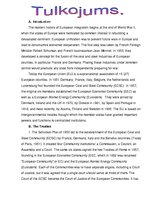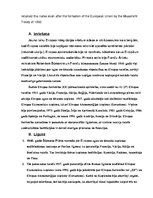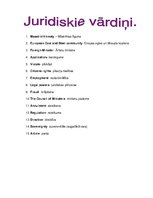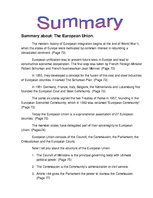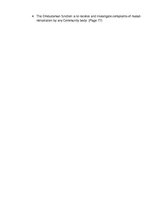-
English Text Translation into Latvian
Summaries, Notes4 Linguistics, Interpreting, History, Culture
A. Introduction
The modern history of European integration begins at the end of World War II, when the states of Europe were motivated by common interest in rebuilding a devastated continent. European unification was to prevent future wars in Europe and lead to constructive economic cooperation. The first step was taken by French Foreign Minister Robert Schuman and French businessman Jean Monnet. In 1950, they developed a concept for the fusion of the coal and steel industries of European counties, in particular France and Germany. Placing these industries under common control would preclude any state from independently preparing for war.
Today the European Union (EU) is a supranational association of 15 (27) European counties. In 1951 Germany, France, Italy, Belgium, the Netherlands and Luxemburg first founded the European Coal and Steel Community (ECSC). In 1957, the original six members established the European Economic Community (EEC) as well as a European Atomic Energy Community (Euroatom).
A. Ieviešana
Jauno laiku Eiropas integrācijas vēsture sākas ar otrā pasaules kara beigām, kad Eiropas valstīm bija kopīgas intereses veicināt izpostīta kontinenta pārbūvi (rekonstrukciju). Eiropas apvienošanās bija lai novērstu nākotnes karus Eiropā un vadīt konstruktīvu ekonomisku sadarbību. Pirmais solis bija Franču Ārlietu ministram Robertam Šūmanim un Franču biznesmenam Žanam Monē. 1950. gadā viņi izstrādāja jēdzienu par ogles un tērauda kausēšanas rūpniecības no Eiropas valstīm, sevišķi Francijā un Vācijā. Liekot šīs rūpniecības zem kopīgas kontroles nepieļaujot nekādu valstu neatkarīgu gatavošanās karam.
Šodien Eiropas Savienība (ES) pārnacionālā apvienība, kura sastāv no 15 (27) Eiropas valstīm. 1951. gadā Vācija, Francija, Itālija, Beļģija, Nīderlande un Luksemburga pirmo reizi atklāja Eiropas ogles un tērauda kopienu. 1957. gadā sākotnējie seši dalībnieki nodibināja Eiropas Ekonomisko kopienu, kā arī Eiropas Atomenerģijas kopienu (Euroatoms).
…
Angļu valodas teksta tulkojums latviešu valodā. 2.darbs

